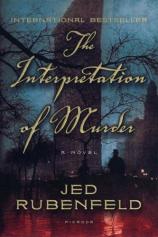The Interpretation of Murder
Review
The Interpretation of Murder
INTERPRETATION OF MURDER by Jed Rubenfeld has been the subject of
much pre-publication publicity, and for good reason. It is a tale
made up of many elements: Sigmund Freud, Carl Jung, eroticism,
Shakespeare, murder, mystery, insanity, and perhaps its most
intriguing character, the city of New York in the early 20th
century. It takes a master craftsman to seamlessly integrate all of
these factors into a cohesive, coherent and exciting tale that by
turns puzzles, titillates, challenges and intrigues. With his debut
novel, Rubenfeld handily earns that title.
The event that opens THE INTERPRETATION OF MURDER is the arrival of
Sigmund Freud in New York; he will give a series of lectures and
receive a prestigious award at Clark University. However, the
primary narrative focus is on Stratham Younger, an American
psychoanalyst representing Clark and a student of Freud's work. A
character of almost equal importance is New York Police detective
Jimmy Littlemore, who is relatively new to the force. His most
important professional asset is his lack of corruptibility.
Younger and Littlemore are slowly but inevitably brought together
by events that parallel each other and eventually seem to intersect
by virtue of similarity. A woman (a stranger to the city) is found,
apparently strangled, in a suite at one of New York's most
luxurious hotels. Littlemore is barely able to begin his
investigation before her body mysteriously disappears. Younger is
recruited by the police department to assist in the investigation
of a vicious assault upon Nora Acton, a young woman of wealthy
parents, in her bedroom. Acton apparently has been rendered mute
and amnesic by the trauma of the assault; Younger is brought in to
treat her in hopes she might help the police.
Meanwhile, Freud appears to be the target of an anonymous campaign
of innuendo and deception meant to derail the receipt of his award
and the presentation of his lectures. The mystery behind these
events leaves trails leading to and from areas as diverse as
Gramercy Park, the impoverished Chinatown, a hospital for the
insane and an engineering marvel known as the Manhattan Bridge. The
plotlines dip and swirl around and across each other, with
discussions of topics such as the Oedipus complex and Shakespeare's
Hamlet woven into their fabrics.
Rubenfeld is a Professor of Law at Yale University and an
acknowledged expert on the topic of United States Constitutional
Law, a topic barely broached --- if at all --- in the novel. But
his grasp of his material is immediate and first-rate. Rubenfeld's
description of New York in 1909 is one that only could have been
borne out of exhaustive research. Still, he does not permit his
narrative to be swallowed up by its backdrop and surroundings. Each
of his characters is memorable in his or her own way. There is a
particular scene, a dinner party that takes place about midway
through the novel, wherein a major character, previously only
mentioned, appears in the flesh. Rubenfeld utilizes this
introduction to delve more deeply into the personalities of other
characters, even as they stand in silent thrall of the new
arrival.
THE INTERPRETATION OF MURDER is as memorable and haunting a book as
has been published this year. If Rubenfeld's Constitutional Law
lectures are half as riveting as this work is, Yale should be
building a stadium for him to handle the attendance. Very highly
recommended.
Reviewed by Joe Hartlaub on January 22, 2011





